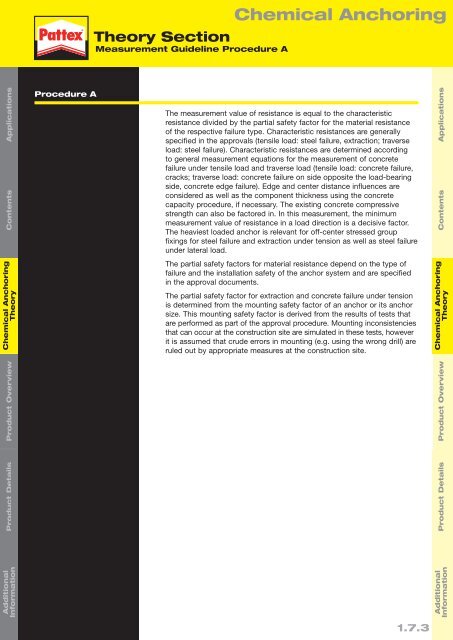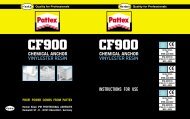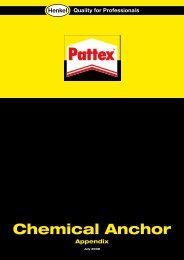Chemical Anchor Technical Handbook
Chemical Anchor Technical Handbook
Chemical Anchor Technical Handbook
You also want an ePaper? Increase the reach of your titles
YUMPU automatically turns print PDFs into web optimized ePapers that Google loves.
Theory Section<br />
Measurement Guideline Procedure A<br />
<strong>Chemical</strong> <strong>Anchor</strong>ing<br />
Product Overview<br />
<strong>Chemical</strong> <strong>Anchor</strong>ing<br />
Theory<br />
Contents Applications<br />
Additional<br />
Information<br />
Additional<br />
Information<br />
Product Details<br />
Product Overview<br />
<strong>Chemical</strong> <strong>Anchor</strong>ing<br />
Contents Applications<br />
Theory<br />
Procedure A<br />
The measurement value of resistance is equal to the characteristic<br />
resistance divided by the partial safety factor for the material resistance<br />
of the respective failure type. Characteristic resistances are generally<br />
specified in the approvals (tensile load: steel failure, extraction; traverse<br />
load: steel failure). Characteristic resistances are determined according<br />
to general measurement equations for the measurement of concrete<br />
failure under tensile load and traverse load (tensile load: concrete failure,<br />
cracks; traverse load: concrete failure on side opposite the load- bearing<br />
side, concrete edge failure). Edge and center distance influences are<br />
considered as well as the component thickness using the concrete<br />
capacity procedure, if necessary. The existing concrete compressive<br />
strength can also be factored in. In this measurement, the minimum<br />
measurement value of resistance in a load direction is a decisive factor.<br />
The heaviest loaded anchor is relevant for off-center stressed group<br />
fixings for steel failure and extraction under tension as well as steel failure<br />
under lateral load.<br />
The partial safety factors for material resistance depend on the type of<br />
failure and the installation safety of the anchor system and are specified<br />
in the approval documents.<br />
The partial safety factor for extraction and concrete failure under tension<br />
is determined from the mounting safety factor of an anchor or its anchor<br />
size. This mounting safety factor is derived from the results of tests that<br />
are performed as part of the approval procedure. Mounting inconsistencies<br />
that can occur at the construction site are simulated in these tests, however<br />
it is assumed that crude errors in mounting (e.g. using the wrong drill) are<br />
ruled out by appropriate measures at the construction site.<br />
Product Details<br />
1.7.3






